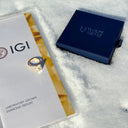Lab vs Natural Diamonds
Lab diamonds ARE real diamonds. They're not fake, not synthetic, not simulants. They're diamonds grown in a lab instead of the ground. Same hardness, same sparkle, same everything. They pass diamond testers because they're actual diamonds.
Why Lab Diamonds Cost Less
Natural diamond sellers charge 85% markup because they control supply. Lab diamonds? We know exactly what they cost to make. A 2-carat natural that costs $15K? Better specs lab-grown: $500. That's not a discount - that's just honest math.
The Truth About Value
Every lab diamond comes from a certified facility. No questionable mining. No blood diamond worries. No made-up stories about 'billion-year journeys.' Just diamonds made by science, sold at fair prices.
Lab Diamond Price Comparison
Compare lab diamond prices to traditional retail pricing:
Compare lab diamond prices to traditional retail pricing:
Engagement Ring
(1.5ct center stone)
Natural: $8,500 | Lab: $1,275 | You Save: $7,225
Stud Earrings
(2ctw)
Natural: $6,000 | Lab: $900 | You Save: $5,100
Statement Pendant
(3ct)
Natural: $27,000 | Lab: $4,050 | You Save: $22,950
The difference in price allows for larger stones or significant savings on your purchase.
Cut - The Most Important Factor: This determines sparkle and brilliance. Choose Excellent or Ideal cut only. A well-cut smaller diamond looks better than a poorly-cut larger one.
Clarity - What Matters to the Eye: VS2 and above means no visible flaws without magnification. VVS or Flawless grades are unnecessary unless viewing under microscope. Invest the savings in size or setting instead.
Color - Finding the Sweet Spot: D-E-F grades are colorless, G-H-I are near colorless. In yellow gold settings, J grade works beautifully. Most people cannot distinguish between F and H grades.
Carat - Understanding Size and Value: Size matters but cut quality matters more. A well-cut stone appears larger than a poorly-cut stone of the same weight. Prices increase exponentially with carat weight - consider that 3.8ct often looks nearly identical to 4ct but costs significantly less.
Both lab and natural diamonds share identical properties - 10 on the Mohs hardness scale, same brilliance, same durability.
The differences:
• 2ct Natural Diamond (G/VS2): $15,000+
• 2ct Lab Diamond (F/VS1): $500
• Natural depreciation: Loses $9,000 value immediately
• Lab depreciation: Loses $200 value immediately
• Environmental impact: Natural requires mining 250 tons of earth per carat
• Environmental impact: Lab requires zero mining
Lab Diamonds Look Different" - False. Lab diamonds are visually identical to natural diamonds because they have the same crystal structure and optical properties. Professional jewelers require specialized equipment to distinguish them.
"They Deteriorate Over Time" - False. Lab diamonds are forever, just like natural diamonds. They maintain their brilliance, don't change color, and never become cloudy. This myth confuses lab diamonds with diamond simulants.
"No Resale Value" - Both natural and lab diamonds depreciate significantly at retail. A $15,000 natural diamond resells for approximately $5,000 (67% loss). A $2,500 lab diamond resells for approximately $1,000 (60% loss). The percentage is similar, but the actual dollar loss is much less with lab diamonds.
IGI Certification for Every Lab Diamond
IGI (International Gemological Institute) is the world's largest independent lab. They test both natural and lab diamonds with the same standards. Every certificate has security features like currency and can be verified online.
What's on your certificate:
- Unique report number
- Exact measurements
- Official 4C grades
- Fluorescence rating
- Security features
Every stone over 1ct comes with IGI certification. Pieces over $5K get full jewelry certification at no cost, upon request.






